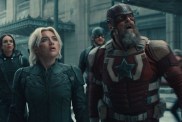I am nostalgic for the period of Music Television from my youth, back when it was the perfect background noise or just the slightest hint of counter-culture, but as an adult, I’ve realized this network was more like a disappointing father who never truly knew how to make amends. Not only did it stop showcasing music in the ways we liked, but it failed several excellent shows by only giving them a single season, especially when it came to mature animation. Out of this handful of shows, Downtown might be the most interesting experiment MTV let slip through their hands.
Officially, the program was referred to as MTV Downtown for legal reasons, but the show was simply called Downtown in almost every other instance. It premiered on a Tuesday night after The Real World, which was fitting for what creator Chris Prynoski wanted to capture. The president of MTV Animation, Abby Terkuhle, referred to it as, “animation vérité,” something drawn and created but that mirrors real life and people closely. In its own way, Downtown is incredibly authentic and every part of the 1999 New York time capsule Prynoski hoped to create. The creators went out into The East Village and interviewed random people, young adventurers out in the nightlife, and those with tales to tell, and many of these individuals and stories became the show’s backbone.
Downtown is a program about a group of acquaintances and their lives living in New York, facing the everyday problems young people were challenged with then, and trying to establish meaningful relationships or find their places in the world. There’s Alex, a 24-year-old nerd who acts as our main character and a self-insert for two of the creators. A young chronic masturbator unsettled by his virginity, his obsession with the confident goth girl from the comic store, Serena, becomes part of the main plot. His younger sister is Chaka, a 17-year-old club kid wild child who is unpredictable, loves to experiment, and cooler than the cool kids, along with her best friend, Mecca, a passionate and sensitive girl who wants to express herself and secure a meaningful relationship. Their friends are Fruity and Matt, two ladies men with vastly different approaches, bold and chill, but both find their own avenues of artistic expression. There’s also Goat, the 26-year-old slightly weird conspiracy theorist who is always seen with a beer in his hand, trying to get laid at the worst dive bars and is seen frequently exposing himself.
To me, the most interesting character in the show is Jen, Alex’s best friend who might be more than that. We’re used to the will they, won’t they stories, but this one feels more real like both of them are afraid of the idea. Jen is so caustic toward Alex having any actual love life that she almost becomes his antagonist. She’s too sarcastic for her own good, unintentionally cruel, and missing so much from her singular existence that she hasn’t realized yet she takes it out on others. She has a roommate named Leah, a vibrant promiscuous girl who takes advantage of her beauty and any man who crosses her path, but this enjoyment of life upsets Jen, showing her jealousy and envy. The episode where they go out on the town together and Jen shows her ass to everyone after a few drinks is priceless. Most people don’t like all of the characters, but it’s easy to find at least one or two to root for.
This friend group feels realistic because they all annoy each other and, in many cases, aren’t even good to one another. Most of them wear their flaws on their sleeves and want to change but don’t know how. Here, we have an extremely diverse group of individuals who had a history before the pilot but barely bothered to learn each other’s real names. They have these full conversations – usually broken up over the episode – that make them feel genuine. I’m sure I’ve had a few of these chats myself and I definitely knew people just like this in college. I like how the group usually pairs off for their adventures, but many stories switch up the groupings to offer different interactions and flesh out the various relationships.
Downtown isn’t one of those shows where people will get distracted by the voice actors and wind up on IMDB instead of paying attention to what’s going on because there are no recognizable voices. Many of the people selected to bring these characters to life were the same ones interviewed to help create the show, most of them having never done anything like this before, explaining why they sound so subdued. A couple of them were even real-life friends and acquaintances, and it shows with the chemistry. A few bad takes were purposefully left in to make interactions seem more natural, the voice talent was encouraged to change lines or even improvise certain scenes, but there were some drawbacks, even a fight in the studio at one point. One of the taglines for the show was, “Drawn from real life,” and they embraced that, but fans were somewhat divided on the voice cast, one of the few aspects of the show that garnered serious criticism.
It’s an MTV product, so there’s no surprise that Downtown is a show about the characters trying to get laid. It isn’t the only thing on their minds, there are themes of change, legacy, and fitting in, but that’s in between talking about porn, shaving genitals, and the fact that most girls like boobs too. Relationships are tough, the sexual tension is thick, and most viewers just wanted these two friends to fuck already. Several of the characters are drawn in less clothes, sometimes just a pair of panties, but there’s no nudity or excessive vulgarity.
“The dame was as sultry as a real sunset but tougher than the last level of Doom II.”
There are also a ton of pop culture references for the time, a few of them surprisingly detailed or alluding to things they probably couldn’t get cleared. Everything from PlayStation and Anime to Star Trek and Chaka being dressed as a Teenage Mutant Ninja Turtle for Halloween, but the guy in the Aeon Flux t-shirt is almost too distracting, and incredibly keen observers may notice WWF’s Undertaker voicing himself as he beats up Sailor Moon cosplayers, or a pre-famous Pedro Pascal as a random character.
The aspect most found interesting about Downtown at first was its art style. The team wanted to preserve the hand-drawn tradition implementing that digital ink and paint technology with minimal corrections. The artists used thin lines that range from simple to exaggerated depending on the shot, with a muted color palette, where the hues change rapidly. Backgrounds are low resolution, usually quite dark, with splashes of bold shadows to create a grunge environment the late ‘90s embraced so much in animation. Real locations and photographs of these places were often recreated in the show. We see some truly excellent stills, entertaining transitions, wild close-ups, tilted angles, reflections, and other hints that they were attempting auteur cinematography on the canvas. It may look familiar, something like Daria or Duckman splashed onto graffiti or a bohemian painting, with clip art moving on top of it. Seeing Prynoski’s work history, this style makes a lot more sense.
The intro is short, sweet, and energetic, sped-up scenes that entice the viewer. The show also utilizes these sudden cutaways – similar to Family Guy – that offer the audience a flashback or fantasy, usually switching up the style. They call these segments “fugues,” and most episodes begin with them. The music is also top-notch, with a few popular songs sprinkled in the episodes, not used in a jarring way or overpowering the scenes, like in Dead at 21. The background tracks are potent when they need to be, but usually chill, making me want to play Grand Theft Auto III.
Downtown was loved by many fans and critics, often called underrated, and it was even nominated for a Primetime Emmy Award, so why didn’t we see a second season? There were 13 episodes created, but the finale didn’t even air in its original run, supposedly debuting months later, and re-runs of the show were broadcast late at night by most accounts. The show wasn’t perfect, that raw feeling it was striving for didn’t pull in everyone, it had a negative depiction of nerd culture and a few other sub-groups while trying to do light social commentary to demonstrate how different types of people go through life, but they never delved into it too much. It always felt like the show was missing a little something.
There was almost a second season, and it was being developed when word officially came down for the cancelation. The original idea had been to switch out most of the cast each season and explore new characters, but after seeing how the first set of episodes came together, they decided to focus on progressing established relationships while bringing in new faces and promoting smaller characters, like Alex’s co-workers, up to major roles.
It had a legacy, at least. Creator Chris Prynoski went on to found Titmouse, a famous animation studio, even though he knew very little about the business when starting Downtown, he brought his chill style and the character of Goat to other cartoons like Megas XLR and Metalocalypse. There was almost no merchandise made for the show originally, and DVDs never happened (most likely due to music licensing), but the creators sold their own versions to make sure loyal fans could have copies of the show and to celebrate the 25th anniversary they’re trying to do t-shirts now.
Prynoski himself isn’t sure why exactly the show was canceled, but at one time MTV was putting a lot of support behind the project, even threatening to sue Mission Hill (which was originally called Downtown) over the title. At some point, though, Downtown lost its push, possibly before it even aired, as most cite the lack of marketing for the show as its downfall, and with the reruns being buried in horrible time slots, it never had a chance. Prynoski seems positive about the overall experience though, thankful that he was even allowed to make these episodes, they aren’t hard to find for people who want to become new fans either. Downtown was close to being art, an animated expression that attempted to become a snapshot in time, and now it’s more like a period piece, a strong comforting reminder of a point in history where MTV almost cared again.










